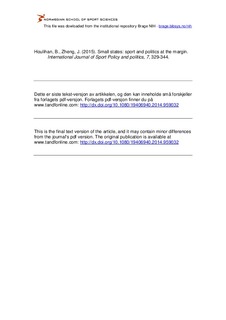| dc.contributor.author | Houlihan, Barrie | |
| dc.contributor.author | Zheng, Jinming | |
| dc.date.accessioned | 2016-04-06T09:28:52Z | |
| dc.date.available | 2016-04-06T09:28:52Z | |
| dc.date.issued | 2014-10-15 | |
| dc.identifier.citation | International Journal of Sport Policy and Politics. 2015, 7, 329-344. | nb_NO |
| dc.identifier.uri | http://hdl.handle.net/11250/2384242 | |
| dc.description | I Brage finner du siste tekst-versjon av artikkelen, og den kan inneholde ubetydelige forskjeller fra forlagets pdf-versjon. Forlagets pdf-versjon finner du www.tandfonline.com: http://dx.doi.org/10.1080/19406940.2014.959032 / In Brage you'll find the final text version of the article, and it may contain insignificant differences from the journal's pdf version. The definitive version is available at www.tandfonline.com: http://dx.doi.org/10.1080/19406940.2014.959032 | nb_NO |
| dc.description.abstract | The aims of this article are the identification of the objectives of small states for participation in international sport and investing in elite sport and the analysis of the strategies that small states adopt to maximize their ability to achieve their sport and non-sport objectives. The article discusses the problem of the definition of smallness and explores objective, relative and subjective definitions. There follows an analysis of the characteristics of vulnerability and capacity in relation to strategy development and a review of the utility of international relations theory for the analysis of small states. The article continues with the identification of five possible strategies that might be adopted by small states (independent/autonomous, isomorphist/imitative, isolationist, collective and camp follower) and the resources needed to operationalize the strategies. Following a brief review of the examples of Singapore and Ireland, the article concludes that the scope for the adoption of independent strategies is likely to narrow given the global ambitions of international federations and the International Olympic Committee. The conclusion also considers the prospects for stimulating research in the area of small state sport policy and argues that the prospects are not good. | nb_NO |
| dc.language.iso | eng | nb_NO |
| dc.publisher | Routledge | nb_NO |
| dc.subject | small states | nb_NO |
| dc.subject | sport policy | nb_NO |
| dc.subject | international relations | nb_NO |
| dc.subject | strategy development | nb_NO |
| dc.subject | sport diplomacy | nb_NO |
| dc.title | Small states: sport and politics at the margin | nb_NO |
| dc.type | Journal article | nb_NO |
| dc.type | Peer reviewed | nb_NO |
| dc.subject.nsi | VDP::Social science: 200 | nb_NO |
| dc.subject.nsi | VDP::Social science: 200::Political science and organizational theory: 240 | nb_NO |
| dc.source.journal | International Journal of Sport Policy and Politics | nb_NO |
| dc.identifier.doi | 10.1080/19406940.2014.959032 | |
| dc.description.localcode | Seksjon for kultur og samfunn / Department of Cultural and Social Studies | nb_NO |
